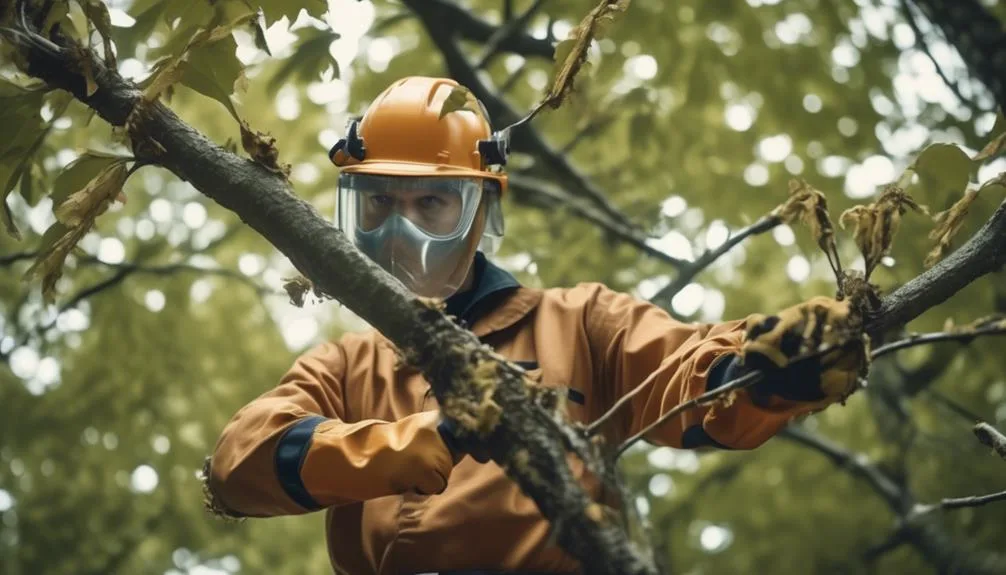Pruning hickory trees properly is crucial for their health and appearance. It can also reduce the risk of disease and damage. But where do you start?
Hickory trees have specific needs that require careful attention. Understanding the right timing, tools, techniques, and potential problems when pruning hickory trees is essential for success.
So, get ready to learn the key elements for achieving the best results.
Timing for Pruning Hickory Trees
When pruning hickory trees, it's crucial to time your pruning activities to coincide with the dormant season. The optimal timing for pruning hickory trees is during late winter or early spring before new growth begins.
Pruning during this period helps minimize the potential damage to the tree and promotes healthy growth. Pruning during the dormant season allows the hickory tree to focus its energy on healing and recovering from any pruning cuts, rather than diverting resources to support new growth.
This timing also reduces the risk of disease or pest infestation that can occur when trees are pruned during active growth periods. By adhering to the recommended pruning season, you can ensure the overall well-being and longevity of your hickory trees.
Tools Needed for Pruning Hickory Trees
To properly prune hickory trees, you'll need the right tools to ensure the health and longevity of the tree, especially considering the optimal timing for pruning during the late winter or early spring.
When pruning hickory trees, it's essential to prioritize safety precautions and use the appropriate tools for the job. The main tools needed for pruning hickory trees include pruning shears for smaller branches, lopping shears for branches with a diameter of up to 2 inches, and a pruning saw for larger branches.
It's important to ensure that all tools are sharp and in good condition to make clean cuts, promoting tree health benefits and reducing the risk of damage or disease.
Additionally, using safety gear such as gloves, goggles, and sturdy footwear is crucial to protect yourself while pruning hickory trees.
Techniques for Pruning Hickory Trees
For effective pruning of hickory trees, employing proper techniques is essential to promote healthy growth and maintain structural integrity.
Start by removing any dead, damaged, or diseased branches using clean pruning shears to prevent the spread of infection.
When dealing with larger branches, use a pruning saw to make a clean cut just outside the branch collar without damaging the trunk.
To maintain the tree's natural shape and encourage strong branch structure, selectively prune overcrowded areas and crossing branches.
Avoid removing more than 25% of the tree's branches in a single season to prevent stress and promote tree health.
Common Mistakes to Avoid When Pruning Hickory Trees
After learning about the proper techniques for pruning hickory trees, it's important to be aware of common mistakes that should be avoided to ensure the tree's health and vitality.
Here are three common mistakes to avoid when pruning hickory trees:
- Over-Pruning: Avoid excessive pruning, as it can stress the tree and lead to decreased vitality. Only remove dead, damaged, or crossing branches to maintain the tree's natural shape and health.
- Pruning at the Wrong Time: Pruning at the wrong time, such as during the growing season, can leave the tree vulnerable to diseases and pests. Always prune hickory trees during their dormant season to promote faster healing and reduce the risk of stress-related issues.
- Improper Pruning Cuts: Making improper pruning cuts, such as leaving stubs or cutting too close to the trunk, can invite diseases and hinder the tree's healing process. Use proper pruning techniques, such as making clean cuts just outside the branch collar, to promote tree health and growth.
Aftercare for Pruned Hickory Trees
Ensure proper aftercare for pruned hickory trees by providing adequate water and mulch to support their healing process and promote new growth. After pruning, it's crucial to maintain the health of the trees to ensure their recovery and continued vitality. Proper soil maintenance and mulching are essential for the hickory trees to thrive. Below is a simple guide to help you ensure the aftercare needs of pruned hickory trees are met:
| Aftercare for Pruned Hickory Trees | Description |
|---|---|
| Watering | Provide regular watering to keep the soil moist, especially during dry periods. |
| Mulching | Apply a 2-4 inch layer of mulch around the base of the tree to retain moisture, regulate soil temperature, and suppress weed growth. |
Conclusion
Incorporating proper pruning techniques is essential for promoting the health and growth of hickory trees. Remember to prune during the dormant season, use sharp tools, and avoid common mistakes such as over-pruning and leaving stubs.
Monitoring for signs of stress or disease is another crucial aspect of caring for hickory trees. By regularly inspecting the trees for any unusual symptoms, you can catch potential problems early and take appropriate action.
Providing adequate care post-pruning is also important. After pruning, it is essential to give the trees the care they need to recover and thrive. This may include watering, fertilizing, or applying mulch around the base of the tree.
By following these practices, you can ensure the well-being of your hickory trees and encourage new growth for a thriving landscape.

My interest in trees started when I first saw the giant sequoias in Yosemite.
I was a teenager then, and I remember thinking, “I need to learn more about this.”
That moment stuck with me.
A few years later, I went on to study forestry at Michigan Tech.
Since graduating, I’ve worked in a mix of hands-on tree care and community education.
I’ve spent over ten years helping people understand how to plant, maintain, and protect the trees in their neighborhoods.
I don’t see trees as just part of the landscape.
They are living things that make a real difference in our daily lives.
